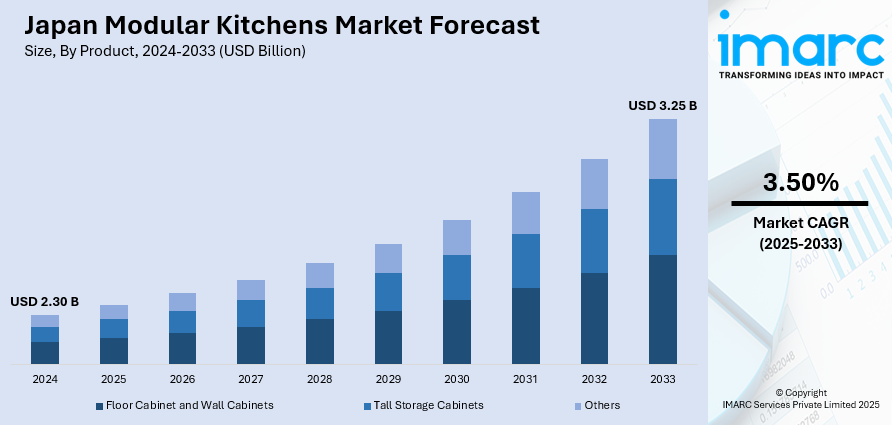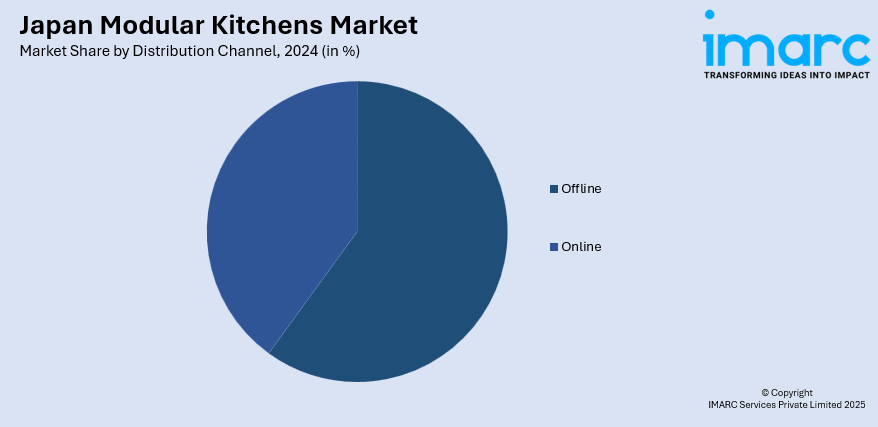
Japan Modular Kitchens Market Size, Share, Trends and Forecast by Product, Distribution Channel, End User, and Region, 2025-2033
Japan Modular Kitchens Market Overview:
The Japan modular kitchens market size reached USD 2.30 Billion in 2024. Looking forward, IMARC Group expects the market to reach USD 3.25 Billion by 2033, exhibiting a growth rate (CAGR) of 3.50% during 2025-2033. The market is witnessing significant growth, driven by the demand for space-efficient and customizable kitchen solutions. Consumers are increasingly opting for contemporary, functional designs to maximize space, increased disposable incomes and home refurbishments, which is also driving the market. With the emphasis on quality, innovation, and sustainability, modular kitchens are gaining popularity among city dwellers. further fueling the Japan modular kitchens market share.
|
Report Attribute
|
Key Statistics
|
|---|---|
|
Base Year
|
2024 |
|
Forecast Years
|
2025-2033
|
|
Historical Years
|
2019-2024
|
| Market Size in 2024 | USD 2.30 Billion |
| Market Forecast in 2033 | USD 3.25 Billion |
| Market Growth Rate 2025-2033 | 3.50% |
Japan Modular Kitchens Market Trends:
Rising Focus on Sustainability
Sustainability is a one of the major drivers of consumer decisions in Japan's market for modular kitchens. As consumers become more environmentally conscious, they are increasingly choosing environment-friendly materials like recycled wood, bamboo, and low-VOC finishes that minimize the carbon footprint of kitchen designs. Energy-saving appliances like smart refrigerators, induction cooktops, and LED lighting are also highly sought after since they contribute to less energy consumption and lower utility bills. Manufacturers nowadays are also using sustainable production methods including minimal packaging, waste reduction, and responsible material sourcing. This trend is not only occasioned by consumer pressure but also facilitated by government incentives and rules advocating for sustainable measures. As a result, sustainability is now a defining feature of modern modular kitchen solutions in Japan.

Growing Demand for Premium Quality and Innovation
In the Japanese modular kitchen market, there has been an increasing demand for high-quality materials and new age features that boost functionality and aesthetics. High-end materials such as engineered wood, stainless steel, and quartz countertops are increasingly being utilized for their durability, sleek look, and ease of maintenance. With these types of materials, consumers are also looking for high-end kitchen amenities like smart storage systems, touchless faucets, and built-in appliances that integrate perfectly into the aesthetic. These technologies, as well as convenience, also establish an even more contemporary and efficient kitchen environment. While consumers value quality and sophistication, demand for high-end, advanced modular kitchen solutions is fueling Japan modular kitchen market growth, with producers leading efforts to supply high-quality, innovative solutions to match these demands.
Rapid Urbanization and Home Renovations
With urbanization gaining pace in Japan, more space-saving and contemporary home solutions like modular kitchens are in demand. As more individuals migrate to cities and settle into smaller apartments, there is a growing demand for kitchens that make the most of available space without compromising on style or functionality. Also, the increase in home remodeling activities, prompted by homeowners wanting to update their residences, further propels demand for modular kitchen solutions. Modular kitchens are flexible in that they can be designed to suit different house sizes and tastes in design, making them a popular option for homeowners who want to upgrade their kitchens when remodeling.
Japan Modular Kitchens Market Segmentation:
IMARC Group provides an analysis of the key trends in each segment of the market, along with forecasts at the country and regional levels for 2025-2033. Our report has categorized the market based on product, distribution channel, and end user.
Product Insights:
- Floor Cabinet and Wall Cabinets
- Tall Storage Cabinets
- Others
The report has provided a detailed breakup and analysis of the market based on the product. This includes floor cabinet and wall cabinets, tall storage cabinets, and others.
Distribution Channel Insights:

- Offline
- Contractors
- Builders
- Others
- Online
A detailed breakup and analysis of the market based on the distribution channel have also been provided in the report. This includes offline (contractors, builders, and others) and online.
End User Insights:
- Residential
- Commercial
A detailed breakup and analysis of the market based on the end user have also been provided in the report. This includes residential and commercial.
Regional Insights:
- Kanto Region
- Kansai/Kinki Region
- Central/Chubu Region
- Kyushu-Okinawa Region
- Tohoku Region
- Chugoku Region
- Hokkaido Region
- Shikoku Region
The report has also provided a comprehensive analysis of all the major regional markets, which include Kanto Region, Kansai/Kinki Region, Central/Chubu Region, Kyushu-Okinawa Region, Tohoku Region, Chugoku Region, Hokkaido Region, and Shikoku Region.
Competitive Landscape:
The market research report has also provided a comprehensive analysis of the competitive landscape. Competitive analysis such as market structure, key player positioning, top winning strategies, competitive dashboard, and company evaluation quadrant has been covered in the report. Also, detailed profiles of all major companies have been provided.
Japan Modular Kitchens Market Report Coverage:
| Report Features | Details |
|---|---|
| Base Year of the Analysis | 2024 |
| Historical Period | 2019-2024 |
| Forecast Period | 2025-2033 |
| Units | Billion USD |
| Scope of the Report |
Exploration of Historical Trends and Market Outlook, Industry Catalysts and Challenges, Segment-Wise Historical and Future Market Assessment:
|
| Products Covered | Floor Cabinet and Wall Cabinets, Tall Storage Cabinets, Others |
| Distribution Channels Covered |
|
| End Users Covered | Residential, Commercial |
| Regions Covered | Kanto Region, Kansai/Kinki Region, Central/Chubu Region, Kyushu-Okinawa Region, Tohoku Region, Chugoku Region, Hokkaido Region, Shikoku Region |
| Customization Scope | 10% Free Customization |
| Post-Sale Analyst Support | 10-12 Weeks |
| Delivery Format | PDF and Excel through Email (We can also provide the editable version of the report in PPT/Word format on special request) |
Key Questions Answered in This Report:
- How has the Japan modular kitchens market performed so far and how will it perform in the coming years?
- What is the breakup of the Japan modular kitchens market on the basis of product?
- What is the breakup of the Japan modular kitchens market on the basis of distribution channel?
- What is the breakup of the Japan modular kitchens market on the basis of end user?
- What is the breakup of the Japan modular kitchens market on the basis of region?
- What are the various stages in the value chain of the Japan modular kitchens market?
- What are the key driving factors and challenges in the Japan modular kitchens market?
- What is the structure of the Japan modular kitchens market and who are the key players?
- What is the degree of competition in the Japan modular kitchens market?
Key Benefits for Stakeholders:
- IMARC’s industry report offers a comprehensive quantitative analysis of various market segments, historical and current market trends, market forecasts, and dynamics of the Japan modular kitchens market from 2019-2033.
- The research report provides the latest information on the market drivers, challenges, and opportunities in the Japan modular kitchens market.
- Porter's five forces analysis assist stakeholders in assessing the impact of new entrants, competitive rivalry, supplier power, buyer power, and the threat of substitution. It helps stakeholders to analyze the level of competition within the Japan modular kitchens industry and its attractiveness.
- Competitive landscape allows stakeholders to understand their competitive environment and provides an insight into the current positions of key players in the market.
Need more help?
- Speak to our experienced analysts for insights on the current market scenarios.
- Include additional segments and countries to customize the report as per your requirement.
- Gain an unparalleled competitive advantage in your domain by understanding how to utilize the report and positively impacting your operations and revenue.
- For further assistance, please connect with our analysts.
 Request Customization
Request Customization
 Speak to an Analyst
Speak to an Analyst
 Request Brochure
Request Brochure
 Inquire Before Buying
Inquire Before Buying




.webp)




.webp)












